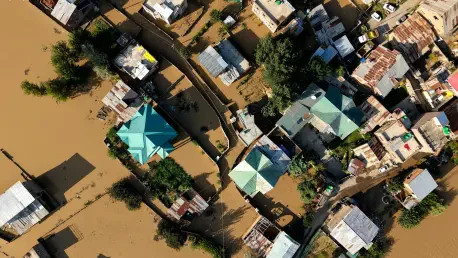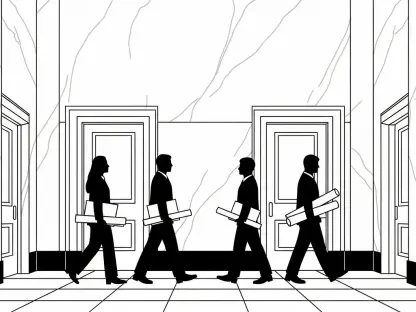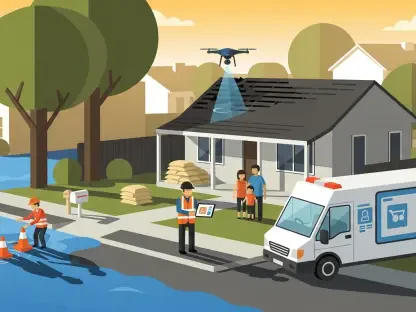A staggering $12.7 trillion worth of American homes stand in the crosshairs of nature’s fury, as extreme weather events like hurricanes, floods, and wildfires grow in frequency and intensity, highlighting a deepening crisis at the intersection of climate change and real estate. This alarming figure, representing over a quarter of the nation’s housing stock, underscores the urgent need for action. Many of these properties lack adequate insurance, leaving homeowners financially exposed while insurers retreat from high-risk areas. The ripple effects threaten not just individual families but the stability of the broader housing market. As rebuilding costs soar and coverage becomes harder to secure, the vulnerability of these homes highlights an urgent need for systemic solutions to protect property values and economic health.
Rising Climate Risks in the Housing Sector
Quantifying the Financial Exposure
The scale of the threat posed by extreme weather is staggering, with more than 25% of U.S. homes facing severe risks from natural disasters, collectively valued at $12.7 trillion. Breaking this down, around 18% of these properties, worth $8 trillion, are susceptible to hurricane winds, while 6.1%, valued at $3.4 trillion, are at risk of flooding. Additionally, 5.6% of homes, totaling $3.2 trillion in value, face the danger of wildfires. These numbers reveal a widespread challenge that cuts across geographic regions and property types. The financial exposure is compounded by the fact that many homeowners in these high-risk areas lack sufficient insurance coverage, either due to affordability issues or simply because they underestimate the likelihood of disaster. This gap in protection not only endangers individual households but also poses a significant threat to the stability of local real estate markets, where a single catastrophic event could trigger widespread economic fallout.
Systemic Implications for Market Stability
Beyond the immediate financial risks to individual properties, the broader housing sector faces systemic challenges as climate threats intensify. Property values in vulnerable areas are increasingly at risk of depreciation, as potential buyers grow wary of the costs and uncertainties tied to natural disasters. Moreover, the lack of adequate insurance coverage amplifies the potential for market destabilization, as uninsured losses could lead to widespread foreclosures or abandoned properties in the wake of a major event. This creates a vicious cycle where declining property values further deter insurers from offering coverage, leaving homeowners with even fewer options. The economic health of entire communities hangs in the balance, as local governments and financial institutions grapple with the downstream effects of reduced tax bases and strained lending environments. Addressing these systemic issues requires a coordinated approach that goes beyond individual homeowner decisions to encompass broader policy and industry reforms.
Insurance Challenges Amid Escalating Costs
Skyrocketing Premiums and Regional Disparities
The escalating cost of home insurance has become a critical barrier for many homeowners in high-risk areas, with premiums often outpacing affordability thresholds. In regions like Miami-Fort Lauderdale, the premium-to-value ratio reaches a staggering 3.7%, meaning a home valued at $614,000 carries an annual insurance cost of $22,718. Similarly, in New Orleans, a 3.6% ratio translates to an $8,328 premium for a median home value of $231,328. Other areas, such as Cape Coral-Fort Myers in Florida, Oklahoma City, and Baton Rouge in Louisiana, also face disproportionately high insurance burdens, particularly in the Southeast and Gulf Coast. These regional disparities highlight how geography plays a significant role in determining financial strain, with many households forced to choose between exorbitant premiums and going without coverage. As insurers continue to withdraw from these high-risk zones, the affordability crisis deepens, pushing more homeowners into precarious financial positions.
Flood Risks and Coverage Gaps
One of the most concerning aspects of the insurance crisis is the widespread underestimation of flood risks, which are not covered under standard home insurance policies. Approximately two million homeowners may be unaware of their significant exposure to flooding, particularly those outside federally designated flood zones. Even within these zones, many lack the necessary separate flood insurance due to cost constraints or a lack of awareness. This coverage gap leaves countless properties vulnerable to devastating losses, as flooding events become more frequent and severe. The challenge is exacerbated by affordability issues, with many homeowners opting to forgo coverage to save on immediate expenses, only to face catastrophic financial ruin later. Experts emphasize that this trend of risky insurance decisions reflects a broader affordability crisis, where the rising frequency and cost of weather-related disasters force difficult trade-offs for millions of households across the country.
Addressing the Crisis for Future Resilience
Bridging the Insurance Divide
Looking back, the response to the growing threat of extreme weather has often fallen short, with many homeowners left to navigate an increasingly complex and costly insurance landscape. Efforts to bridge the coverage divide have revealed the depth of the challenge, as insurers scaled back operations in vulnerable areas, leaving gaps that public and private initiatives struggled to fill. Reflecting on past attempts, it became clear that innovative solutions, such as risk-sharing models or government-backed insurance programs, have been tested with varying degrees of success. These approaches aimed to distribute the financial burden more equitably, preventing homeowners from bearing the full weight of disaster recovery. Yet, the persistent retreat of private insurers underscores a critical lesson: sustainable solutions require addressing the root causes of affordability while ensuring that coverage remains accessible to those most at risk.
Building a Path to Systemic Reform
In retrospect, the push for systemic reform in the housing and insurance sectors has gained traction as the scale of climate risks became undeniable. Discussions around stronger building codes, improved flood mapping, and incentives for mitigation measures have taken center stage, offering hope for reducing future losses. Policymakers and industry leaders have explored ways to stabilize property values in high-risk areas by integrating climate resilience into urban planning and real estate development. Additionally, there is a growing recognition of the need for public education campaigns to raise awareness about flood risks and insurance options. Moving forward, the focus should shift toward actionable steps, such as expanding federal support for disaster preparedness and fostering partnerships between insurers, governments, and communities. These efforts, built on past lessons, hold the potential to safeguard trillions in home value while protecting the economic foundation of countless neighborhoods against the relentless advance of extreme weather.









